Crate Training 101: Everything You Need to Know for a Happy and Comfortable Pup
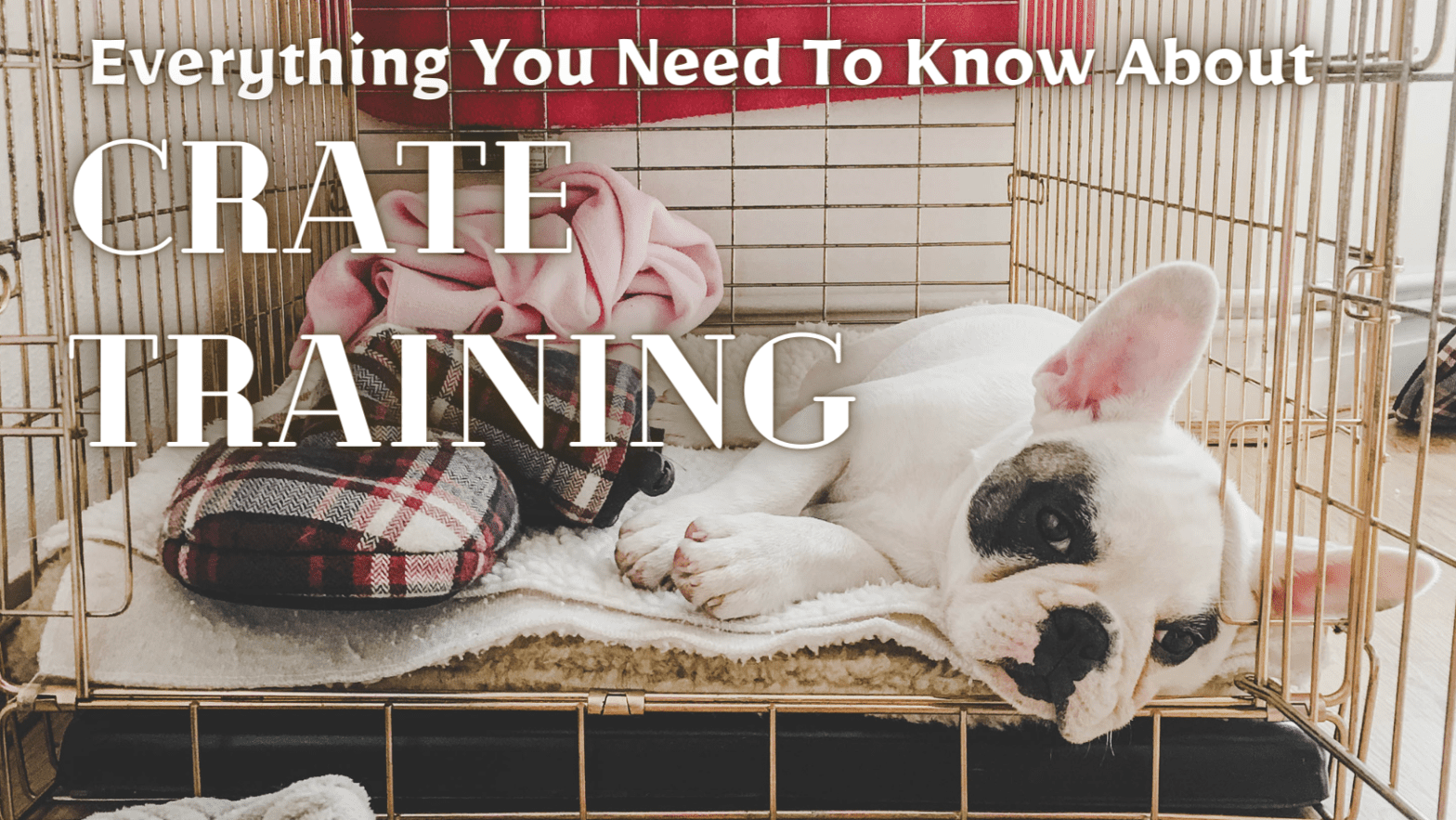
Admin
Published On Feb 11,2023
Crate training is a popular and effective method for teaching dogs obedience and good behaviour especially when used in conjuction with additional positive puppy training. By providing a safe and secure space, dogs learn to become comfortable in their crates which is beneficial later down the track for puppies, who are still learning the rules of the house, and for adult dogs who may need a place to retreat and relax. In this article, we’ll explore the ins and outs of crate training from the benefits of crate training and choosing a crate to common myths associated with crate training and how to get started with the training process.
Table of Contents
ToggleTry out Freework with your dog!
Jump To:
What are the different types of crates?
Why should I crate train my dog?
How do I choose the right size crate for my puppy?
What are some common myths about crate training?
What age should I start crate training my puppy?
How do I start crate training my puppy?
Should I put my dog in a crate at night?
Should I put a blanket over my dog’s crate?
Is it ok to leave toys in my dog’s crate?
Should my dog’s crate be in bedroom or living room?
Should I put a pee pad in my puppy’s crate?
Should I leave water in my puppy’s crate overnight?
What should I put in my dog’s crate?
Should I ignore my puppy crying at night?
What are the different types of crates?
There are several different types of dog crates available on the market, each with their own unique features and benefits. Some of the most popular types of crates include:
- Wire crates: These crates are made of metal wire and are the most common type of crate. They are durable, easy to clean, and allow for good ventilation. Some models come with a removable plastic pan for easy cleaning.
- Plastic crates: Plastic crates are made of durable, lightweight plastic and are often used for air travel. They are easy to clean, provide good ventilation, and are also stackable, making them great for storage.
- Soft-sided crates: Soft-sided crates are made of fabric and mesh and are lightweight and portable. They are a great option for small dogs, as well as for dogs who need to be crated for short periods of time.
- Wood crates: Wood crates are made of solid wood and are often used as decorative furniture. They provide a cozy and comfortable environment for dogs and can be stained or painted to match your home decor.
- Heavy-duty crates: Heavy-duty crates are made of strong metal and are designed for dogs who are prone to chewing or digging. They are also a good option for larger dogs who may need a sturdier crate.
When choosing a crate, it is important to consider the size of your dog and their behaviour. You want a crate that is big enough for them to comfortably stand, turn around, and lie down, but not so big that they have room to use one end as a bathroom and the other as a bedroom. Additionally, if your dog is an escape artist, you may want to opt for a stronger, heavy-duty crate.
Why should I crate train my dog?
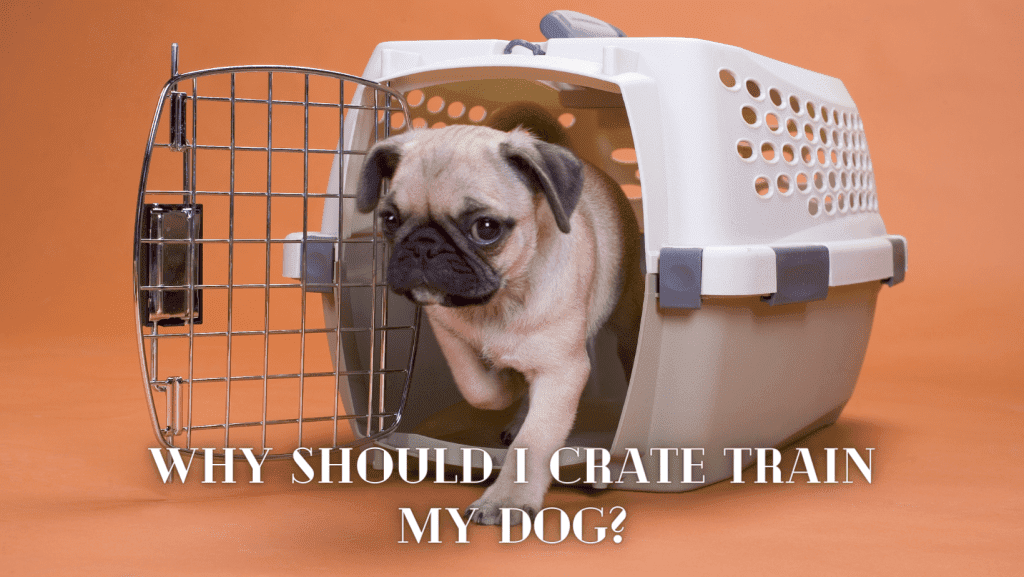
Crate training offers several benefits for both dogs and their owners. Some of the key benefits include:
- Potty training: Crates can be an effective tool for potty training puppies, as dogs naturally do not want to eliminate in the area where they sleep.
- Safety: Crates provide a safe and secure space for dogs when they need to be left alone. This can prevent accidents and destructive behavior, as well as protect them from harm in the event of a natural disaster or other emergency.
- Anxiety relief: Some dogs may suffer from separation anxiety when left alone. By providing a cozy and familiar space, a crate can help to alleviate their anxiety and reduce stress.
- Training tool: Crates can be used as a training tool to teach dogs obedience and good behavior. By requiring them to stay in their crates for short periods of time, dogs learn to be calm and patient.
- Travel: Crates can make traveling with dogs safer and more convenient. Many airlines require dogs to be transported in crates, and having a crate can also help to keep them secure and comfortable in the car.
- Dental health: Chewing on the crate’s metal wire bars can help to keep a dog’s teeth clean and healthy.
Crate training can be a positive and rewarding experience for dogs and their owners. With proper training, dogs will come to view their crates as a safe and comfortable place, and owners will have peace of mind knowing their furry friends are safe and secure.
How do I choose the right size crate for my puppy?
When choosing a crate size for your puppy, it is important to consider their expected adult size and growth rate. You want a crate that is big enough for them to comfortably stand, turn around, and lie down in, but not so big that they have room to use one end as a bathroom and the other as a bedroom.
Here’s how to choose a crate size for your puppy:
- Measure your puppy: Measure your puppy from the tip of their nose to the base of their tail and from the floor to the top of their shoulder.
- Choose the right size: Based on the measurements, choose a crate size that will accommodate your puppy when they reach their full adult size. Most crates will specify the recommended weight and size range for each model.
- Consider growth rate: If your puppy is a breed that grows rapidly, consider purchasing a crate that is suitable for their full adult size, even if they will only use it for a short period of time.
- Divider panel: Some crates come with a divider panel that allows you to adjust the size of the crate as your puppy grows. This can be a cost-effective solution as you will only need to purchase one crate for your puppy’s entire lifetime.
Hot Tip
Remember, dogs should never be left in a crate for extended periods of time, 2 hours should be the maximum amount of time in any one sitting. Provide plenty of exercise, potty breaks, and playtime to keep your puppy happy and healthy.
What are some common myths about crate training?
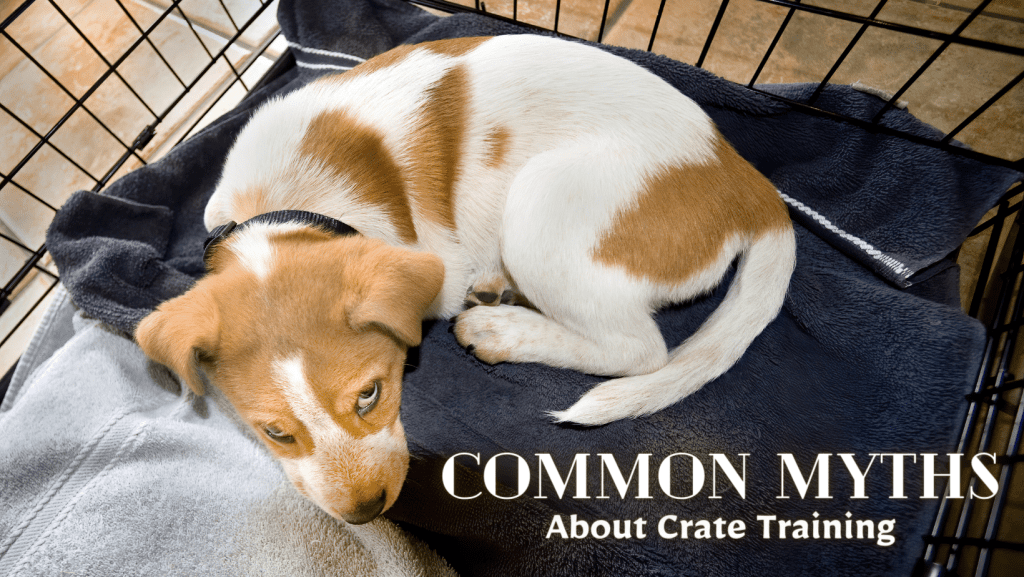
Crate training has been the subject of many myths and misconceptions over the years, which can make some pet owners hesitant to try it. Here are some of the most common myths about crate training and why they are incorrect:
- Crates are cruel: This is one of the most common myths about crate training. However, when used properly, crates can provide a safe and comfortable space for dogs. Crates can help dogs feel secure and calm, and can prevent destructive behavior. Remember, the dog doesn’t think crates are cruel – humans place their human emotions onto dogs. .
- Dogs will become addicted to their crates: Another common myth is that dogs will become addicted to their crates and will never want to leave them.
- Crates limit a dog’s exercise: Some people believe that crates limit a dog’s exercise and prevent them from getting enough physical activity. However, crates should only be used for short periods of time and dogs should still have plenty of opportunities for exercise and play.
- Dogs will develop separation anxiety: Another myth is that dogs will develop separation anxiety if they are crated for too long. In reality, separation anxiety is a behavioural issue that can be caused by many different factors, and crate training can actually help to reduce separation anxiety in some dogs.
In conclusion, crate training can be a beneficial and positive experience for dogs and their owners. By debunking these myths and understanding the benefits of crate training, pet owners can help their furry friends to become well-behaved and happy pets.
What age should I start crate training my puppy?
You can start crate training your puppy as soon as you bring them home, usually at 8 to 12 weeks of age. This is the perfect time to start introducing your puppy to the crate, as they are still in the process of forming habits and adjusting to their new environment.
Here are some tips for starting crate training your puppy:
- Gradual introduction: Gradually introduce your puppy to the crate by leaving the door open and offering treats and toys inside. Let your puppy explore the crate at their own pace and get comfortable with it.
- Short training sessions: Start with short training sessions, gradually increasing the length of time your puppy spends in the crate. Avoid leaving them in the crate for extended periods of time.
- Positive reinforcement: Use positive reinforcement techniques such as treats, praise, and toys to encourage your puppy to enter the crate and stay inside.
- Avoid punishment: Do not use the crate as a form of punishment. The crate should be a positive and comfortable space for your puppy.
- No forced confinement: Do not force your puppy into the crate if they start resisting. Of course, feel free to pick your puppy up and place them inside the crate – but if your puppy is seriously fighting you to stay out you shouldn’t be struggling to force them in. If this is happening, you should consult a professional to come in and assist.
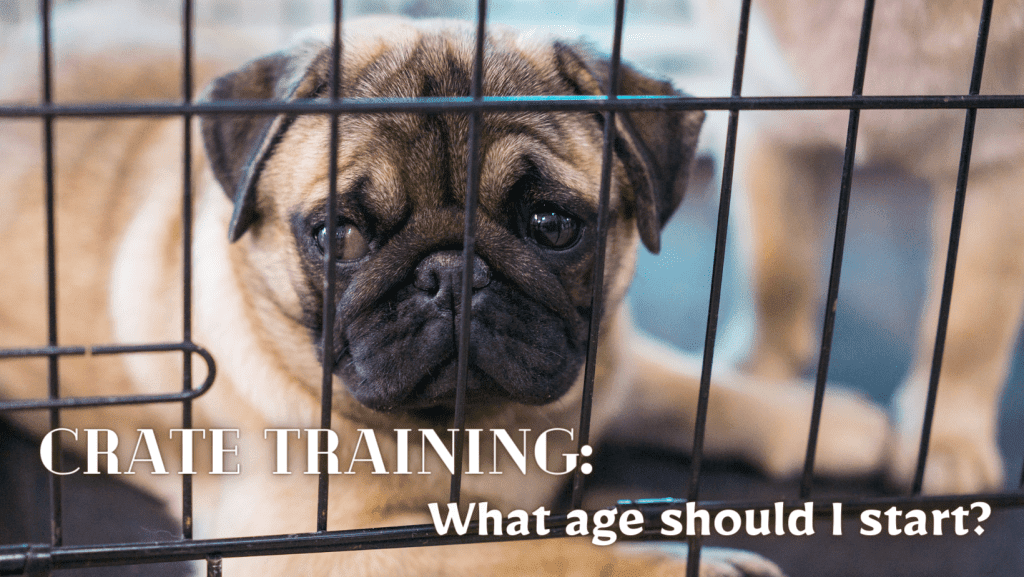
By starting crate training at a young age, you can help your puppy to become familiar with the crate and view it as a safe and comfortable place. This can make the transition to their new home easier and help to prevent behaviour problems in the future.
How do I start crate training my puppy?
Crate training your puppy can be a positive and effective way to help them feel safe and secure. Here are the steps to start crate training your puppy:
- Choose the right crate: Choose a crate that is appropriate for your puppy’s size and breed, and make sure it is big enough for them to comfortably stand, turn around, and lie down in.
- Gradually introduce the crate: Gradually introduce your puppy to the crate by leaving the door open and offering treats and toys inside. Let your puppy explore the crate at their own pace and get comfortable with it.
- Make the crate a positive place: Use positive reinforcement techniques such as treats, praise, and toys to encourage your puppy to enter the crate and stay inside.
- Short training sessions: Start with short training sessions, gradually increasing the length of time your puppy spends in the crate. Avoid leaving them in the crate for extended periods of time.
- Establish a routine: Establish a routine for feeding, potty breaks, and crate time. This will help your puppy to understand when it is time to go in the crate and when it is time to come out.
- Avoid punishment: Do not use the crate as a form of punishment. The crate should be a positive and comfortable space for your puppy.
With patience, consistency, and positive reinforcement, your puppy will soon learn to love their crate and view it as a safe and comfortable place.
Should I put my dog in a crate at night?
Yes, it is generally recommended to crate train your dog and have them spend time in their crate at night. Crates can provide a safe and comfortable place for dogs to sleep, and can prevent destructive behavior and accidents in the home.
Here are some tips for crate training your dog at night:
- Gradual introduction: Gradually introduce your dog to the crate and make sure they are comfortable with it before using it for nighttime.
- Consistent bedtime routine: Establish a consistent bedtime routine that includes potty breaks and a settling-in period in the crate.
- Make the crate comfortable: Make sure the crate is comfortable with a soft, cozy bed and a blanket for your dog to snuggle with.
- Avoid punishment: Do not use the crate as a form of punishment. The crate should be a positive and comfortable space for your dog.
By making the crate a positive and comfortable place for your dog, you can help them to view it as a safe and cozy space to sleep at night. This can lead to better sleep for both you and your dog and can prevent behavioural issues in the future.
Should I put a blanket over my dog’s crate?
Yes, you can put a blanket over your dog’s crate to provide them with a cozy and comfortable place to sleep. A blanket can also help to create a sense of security and reduce noise and light levels, making the crate a more inviting place for your dog.
When choosing a blanket for your dog’s crate, consider the following:
- Size: Make sure the blanket is big enough to cover the entire bottom of the crate and provide plenty of room for your dog to move around.
- Material: Choose a soft and comfortable material that will not irritate your dog’s skin.
- Easy to clean: Consider a material that is easy to clean in case of accidents.
- Non-toxic: Ensure the blanket is non-toxic and safe for your dog to be in contact with.
- Secure: Make sure the blanket is secure and will not get tangled up in your dog’s paws or cause any other issues.
Overall, a blanket over a dog’s crate can provide comfort and security and can help make the crate a more inviting place for your dog to sleep.
Is it ok to leave toys in my dog’s crate?
Yes, it is generally okay to leave toys in your dog’s crate. Toys can provide mental stimulation and help keep your dog entertained while they are in the crate. Providing your dog with toys can also help to create a positive association with the crate and make it a more inviting place for them to be.
When choosing toys to leave in your dog’s crate, consider the following:
- Safety: Make sure the toys are safe for your dog and do not pose a choking hazard.
- Durability: Choose toys that are durable and can withstand chewing and rough play.
- Size: Make sure the toys are an appropriate size for your dog and will not get stuck in the crate.
- Interest level: Consider your dog’s individual interests and choose toys that they are likely to enjoy and interact with.
Overall, leaving toys in your dog’s crate can provide mental stimulation and help to make the crate a more inviting and positive place for your dog. Just be sure to choose toys that are safe, durable, and appropriate for your dog’s size and interests.
Should my dog’s crate be in bedroom or living room?
The location of your dog’s crate will depend on your individual circumstances and your dog’s individual preferences. There are benefits to both having the crate in the bedroom and in the living room.
Having the crate in the bedroom can provide a sense of security for your dog, especially at night when they are sleeping. This can help to reduce separation anxiety and promote better sleep for both you and your dog.
Having the crate in the living room, on the other hand, can provide your dog with more social interaction and stimulation during the day. This can be especially beneficial for dogs who are prone to separation anxiety or who enjoy being near their family.
Ultimately, the best location for your dog’s crate will depend on your individual lifestyle and the needs of your dog. Some dogs may prefer the comfort and security of the bedroom, while others may prefer the social stimulation of the living room. Experiment with different locations and observe your dog’s behaviour to determine the best location for their crate. You could always have more than one crate, a crate in different areas of the house.
Should I put a pee pad in my puppy’s crate?
It depends on the individual needs of your dog and the reasons for using the crate. Pee pads can be useful for house training or for dogs who are not yet fully house trained and may have accidents in the crate. However, using pee pads in the crate can also create confusion for the dog about where it is appropriate to go to the bathroom and may hinder the house training process.
Here are a few things to consider when deciding whether to use a pee pad in the crate:
- House training status: If your dog is already fully house trained and has not had accidents in the crate, a pee pad may not be necessary.
- Age: Young puppies may benefit from the use of a pee pad in the crate.
- Health issues: Dogs with medical conditions that make it difficult for them to hold their bladder may benefit from a pee pad in the crate.
- Size: Make sure the pee pad is the appropriate size for the crate and will not get stuck in the crevices.
It’s important to note that if you do choose to use a pee pad in the crate, you should continue to take your dog outside for regular potty breaks to prevent confusion and reinforce the appropriate place to go to the bathroom.
Overall, whether or not to use a pee pad in the crate will depend on the individual needs of your dog and the reasons for using the crate. Consider these factors and work with a veterinarian or a professional dog trainer to determine the best approach for your dog.
Should I leave water in my puppy’s crate overnight?
Whether or not to leave water in your dog’s crate overnight will depend on several factors, including your dog’s age, health, and drinking habits. Here are a few things to consider:
- Age: Younger puppies may not be able to hold their bladder overnight and may need to go out to relieve themselves during the night. Older dogs may be able to hold their bladder and may not need access to water overnight.
- Health: Dogs with medical conditions that affect their bladder or kidneys may need access to water overnight. It’s best to consult with a veterinarian to determine what’s best for your dog.
- Drinking habits: Some dogs may drink excessive amounts of water and may need to go out to relieve themselves more frequently during the night. Others may not drink much at all and may not need access to water overnight.
- Weather: Consider the temperature and humidity, as hot and dry weather can increase a dog’s need for water.
If you decide to leave water in the crate overnight, it’s important to make sure the water is easily accessible to your dog and that the bowl is not tipped over or spilled. You should also check the water level in the morning and refill it as needed.
Overall, whether or not to leave water in your dog’s crate overnight will depend on several factors, including your dog’s age, health, and drinking habits. Consult with a veterinarian or professional dog trainer to determine the best approach for your dog.
What should I put in my dog’s crate?
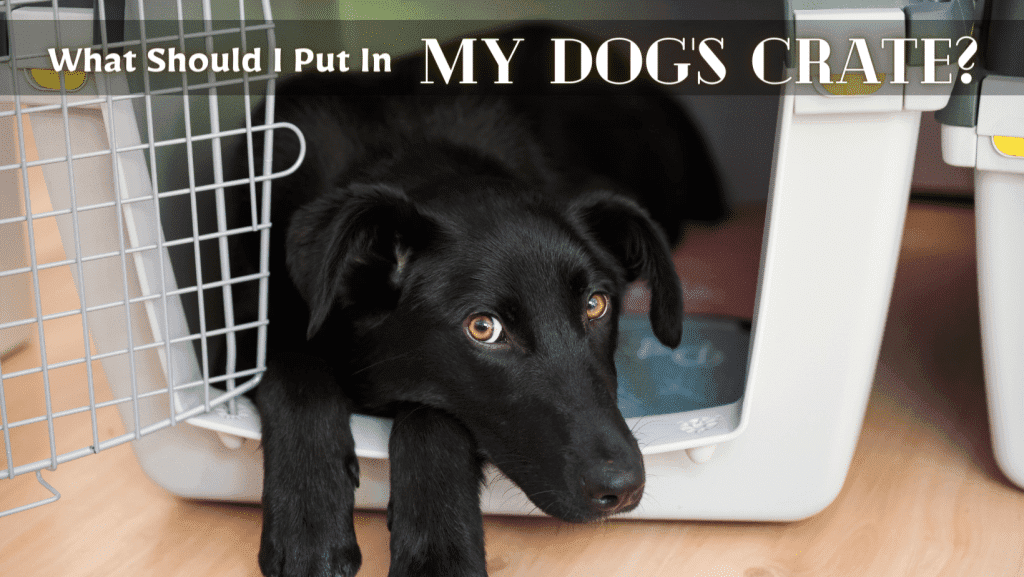
What you put in your dog’s crate will depend on your individual dog’s needs and preferences. Here are a few essentials to consider:
- Bed or blanket: Providing a comfortable bed or blanket will help your dog feel more secure and comfortable in the crate.
- Toys: Providing toys, such as chew toys or interactive toys, can help keep your dog entertained and mentally stimulated while in the crate.
- Treats: Treats can be used to coax your dog into the crate and to reinforce positive behaviors while in the crate.
- Water: A water bowl should be provided if your dog will be in the crate for an extended period of time.
- Treats: Treats can be used to coax your dog into the crate and to reinforce positive behaviors while in the crate.
It’s important to remember that anything you put in the crate should be safe and non-toxic, and should not pose a choking or strangling hazard to your dog. Avoid leaving anything sharp or breakable in the crate with your dog.
Overall, what you put in your dog’s crate will depend on your individual dog’s needs and preferences. Provide items that will make the crate a comfortable and safe space for your dog.
Should I ignore my puppy crying at night?
Ignoring your puppy’s crying at night can be a difficult thing to do, but it may be necessary in certain circumstances. Here are a few things to consider:
- Potty breaks: Make sure your puppy has had a potty break before bedtime and has access to a place to relieve themselves overnight if necessary.
- Comfort: Provide your puppy with a comfortable bed or blanket, toys, and anything else they may need to feel secure in the crate.
- Separation anxiety: If your puppy is crying because they are experiencing separation anxiety, it’s important to address the underlying issue and not simply ignore the behavior. Work with a professional dog trainer to develop a plan to help your puppy overcome their separation anxiety.
- Training: If your puppy is crying because they are not used to being in the crate, it’s important to slowly acclimate them to the crate through positive reinforcement and consistent training.
If your puppy continues to cry despite these steps, it may be necessary to ignore the behavior for a brief period of time. However, it’s important to check on your puppy regularly to make sure they are safe and not in distress.
Ignoring your puppy’s crying at night can be a difficult thing to do, but it may be necessary in certain circumstances. Work with a professional dog trainer to determine the best approach for your individual puppy.
The Takeaway
In conclusion, crate training can provide many benefits for both you and your puppy, including improved potty training, increased safety and security, and a sense of comfort and routine for your puppy. It’s important to choose the right size crate for your puppy and to slowly acclimate them to the crate through positive reinforcement and consistent training. Common myths about crate training, such as that it is cruel or that dogs should never be left in a crate overnight, have been debunked. However, it’s important to provide your puppy with a comfortable and safe environment while in the crate, including a bed or blanket, toys, and access to water as needed. If your puppy is experiencing separation anxiety or crying at night, it’s important to work with a professional dog trainer to address these issues. By following these guidelines, you and your puppy can enjoy the many benefits of a successful crate training experience.





